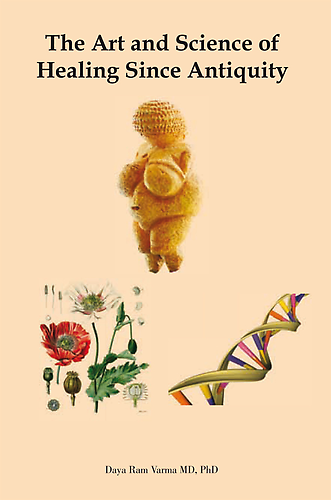The Art and Science of Healing Since Antiquity. By Daya Ram Varma, MD, PhD. www.Xlibris.com, 2011.
***
Why should a book on the history of medicine be reviewed in a magazine mainly dealing with the arts, culture and politics? Because this book has it all: an insight into the art of healing, an understanding of how culture can advance or hinder medical science and a mordant analysis of how politics can affect, for better or for worse, the health of a nation’s citizens.
First of all, a word about the author. Indian-born Daya Varma is a Professor Emeritus of McGill University in Montreal, world renowned medical school. He is best known for his research in pharmacology and for his scientific and humanitarian work involving longitudinal studies of the survivors of the Union Carbide tragedy in Bhopal, India, which killed thousands of people. He is also known for his political activism which, as far as he is concerned, should never be divorced from his work as a scientist. His book reflects these concerns.
The initial chapters explain how medicine, being both an art as well as a science, branched into different schools, a phenomenon not seen in other scientific disciplines. Dr. Varma also traces the influence of sociopolitical determinants on medical advances. He emphatically differentiates what he calls “witchcraft” from what he calls materialist medicine, but fails to make a feminist analysis of how witches in medieval Europe were persecuted, not because they might be poor healers, but because of the threat they posed to a patriarchal and ecclesiastical political order. Women who could not only heal, within the limits of the knowledge of their times, but also provide contraception and abortions, were a threat to male authority.
The author also lumps major alternative healing systems such as Ayurveda, Chinese medicine and acupuncture, homeopathy and Unani-Tibb or Islamic medicine under the generic term of witchcraft, which is an extreme simplification of a very complex reality. After all, there are many modern scientific studies validating the benefits of acupuncture in pain management and anesthesia, the blood-pressure lowering effects of meditation and the possible benefits of the blood-thinners present in the saliva of leeches for the treatment of strokes. Varma is rather dismissive of all alternative therapies and seems to allow no room for the mind-body connection in healing, which is rather strange considering that he recognizes that medicine is both an art as well as a science. On the other hand, he does a wonderful job of explaining the therapeutic mechanisms of pharmacological substances in a manner which a lay person can easily grasp. And his warning against being seduced by therapies that are not evidence-based is a point well taken. He also warns his readers that natural substances can be as toxic and harmful as their synthetic counterparts. Varma very rightly concludes that people resort to charlatans and unproven remedies because mainstream medicine might not be easily available to them or because the limits of science have failed them.
One of the postulates of this richly-documented book is that modern medicine did not start with the Greeks, but actually had its birth before that, in ancient civilizations like the ones that thrived in the Gangetic Plain, the Yang-Tse River Basin and the Nile Valley. For Varma, the true birthplace of modern medicine is Egypt, not Greece. The author, however, explains that there are gaps in the evolution of modern medicine, most probably due to the material conditions prevailing then. For science to be able to develop, a capitalist mode of production is necessary, and that requires going beyond feudalism. This explains why, according to Varma, Europe produced so much in terms of scientific discovery when it outgrew its feudal economy and why the United States, with its importation of European brains and the absence of a feudal past, has become a leader in medical research and technology. However, Daya Varma is quick to point out that in spite of being such a rich country, the United States has failed to look after the health of all of its citizens unlike Cuba, which has one of the best public health systems in the world.
Another important message contained in The Art and Science of Healing Since Antiquity is that countries can, and should, mobilize their resources in looking after the health of their citizens the way they mobilize resources during natural disasters or catastrophes.
This richly-documented book is a treasure-trove of information on the history of epidemics, diseases, discoveries, medicaments, theories and myths. It is also a brilliant collection of memorable quotes, paired in opposites, opening each chapter. Einstein, Marx, Engels and Shelley are equally pressed into service to illustrate the novel ideas of a book which is a delight to read and difficult to put down. The author’s humour and originality trump the minor errata and typos apparent in the preliminary version available to this reviewer. These will, however, be eliminated from the final edition.
